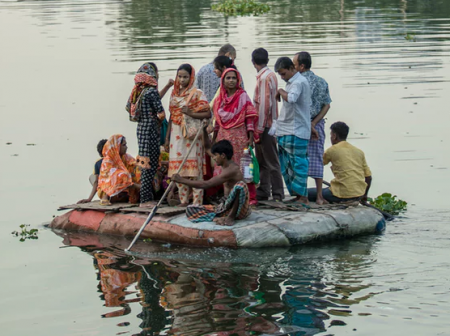June 23, 2018 – In an April issue of The Economist, an article describes the current and growing global refugee problem. Of the 20 plus million in the world today, a number that is the largest displacement of people since World War Two, almost 90% continue to reside in the Developing World. Yet it is in the Developed World where the outcry is loudest about allowing refugees to enter countries with far greater means to absorb the influx. A number of European Union countries are meeting this weekend to discuss a uniform policy for displaced populations increasingly attempting to enter the continent from The Middle East and Africa. In the United States, the Donald Trump administration in its “zero-tolerance policy” towards asylum seekers from Central and South America has created a political headache for itself that could reverberate and negatively impact the Republicans in the upcoming mid-term elections this year.
The current causes of displacement from Africa, the Middle East, Asia, and Central and South America include ongoing wars either regional, civil, or drug-related, famine from crop failures, and prolonged drought. These movements of people can be foreseen. It is not difficult to pinpoint triggering events impacting vulnerable populations.
Take for example the Syrian civil war now into its seventh year. What precipitated it? Was it inspired by The Arab Spring that began in Tunisia, or was it the prolonged drought in eastern Syria that impacted farmers, further exacerbated by a heavy-handed government that was unresponsive to a population in dire need?
After World War Two the United Nations attempted to address the issue of mass movement of displaced persons as an outcome of the war itself, the redrawing of political boundaries in Europe, the Soviet Union’s post-war absorption of Eastern Europe into its sphere of influence, and European decolonization in Asia and Africa leading to regional and civil conflicts. In 1951 a United Nations convention described refugees as “any person who owing to a well-founded fear of being persecuted for reasons of race, religion, nationality, membership of a particular social group or political opinion is outside the country of his nationality and is unable, or owing to fear is unwilling to avail himself of the protection of that country; or who, not having a nationality and being outside the country of his former habitual residence, is unable, or having such fear is unwilling to return to it.” By that definition, those seeking asylum in Europe by crossing the Mediterranean in flimsy boats, those fleeing war and religious persecution from unfriendly governments, and those suffering from famine and likely starvation, have legitimate cause to seek sanctuary in nations that are signatories to the 1951 convention. But, for the most part, the Developed World is turning a blind eye to displaced people while the number of them continues to grow.
In the global scheme of things where more than 7.5 billion of us live on this planet, 20 million is a drop in the bucket, not even 0.3% of our total population. Some accountant might even refer to it as a rounding error. But these are real people, families with children (in the case of the U.S., families being separated from their children and being confined to abandoned Walmarts and military bases). The disregard for the seriousness of their plight and the lack of humanity in addressing their needs is a stain on the nations of the Developed World.
But this is just the beginning of a wave of human displacement that the United Nations and the International Panel on Climate Change predict will be far greater than the numbers we cannot seem to handle today. This coming wave of which presently we are seeing only a trickle will be climate change refugees. What kind of numbers are we talking about? Not 20 million, not 200 million, but as many as 2 billion by the late 21st century.
Why?
- Because many inland areas in the Middle East and Asia will see rising temperatures that will make these areas largely uninhabitable.
- Because rising sea levels will force people to leave coastlines to find higher ground.
- Because extreme and sudden weather events will lead to further displacement.
- Because drought will drive people from farmland.
The evidence of a growing number of climate change refugees is already upon us. For example, in June of 2017, the following happened:
- 660,000 people were evacuated from provinces in Southern China because of sudden heavy rainfalls, landslides, and floods.
- 22,000 people in Myanmar had to leave their homes destroyed by Cyclone Mora.
- 78,000 people in Sri Lanka were inundated by flash floods and landslides destroying thousands of homes and isolating many villages.
In all three of the above cases, climate displacement is internalized within these countries. But what happens when an entire country is overwhelmed by climate change impacts such as is occurring in some of the Pacific and Indian Ocean island nations. In the last few years, eight islands in Micronesia have succumbed to rising sea levels. Kiribati, Tuvalu, the Marshall Islands, the Maldives, and others may all cease to exist as countries. The populations of these nations are relatively small, much less than the 20 plus million of refugees the world is currently attempting to address. But they are the tip of the iceberg in terms of those who will be displaced by climate change.
Take the nation of Bangladesh where climate change refugees already are crowding into Dhaka, the nation’s capital. In a photo essay posted last January in The Guardian, it shows boats passing over where homes once existed. A combination of monsoonal rains and rising sea levels have displaced thousands and destroyed their lands. There is no going back for these people. Repeated saltwater inundations have made any land that periodically rises above sea level unfarmable. As much as 20% of this country of over 160 million will be inundated before century end. The areas under threat house far more than 20% of the country’s population (an estimated 30 million) which means a climate refugee population greater than the total number of current refugees on the planet. Short of a massive and expensive effort to engineer the equivalent to the dikes and polders of The Netherlands, much of Bangladesh will be lost or become uninhabitable. This scenario will be repeated in many other coastal nations. Those in the Developed World may have the funds to hold back rising seas by building massive sea walls, but even then large areas of inhabited land will be lost. And in the Developing World, there won’t be the money to invest in infrastructure to deal with sea level rise, just people on the move who have lost their land, homes, and livelihood.
In this unpalatable scenario, the large-scale displacement of people will dwarf the current population pressures being felt by Europe and the United States. The current United Nations convention on refugees doesn’t include climate change. For the moment only New Zealand formally recognizes this cause as grounds for refugees claiming asylum. But even then the number of special visas is limited to 100 annually. That’s a pittance compared to the number of Pacific island nation refugees expected in the coming decades.
Meanwhile “zero tolerance” policies such as those on display in the United States and Italy these last few days will ultimately fail as climate change pressures alter human demographics by peaceful means or otherwise. Even the American military under President Obama’s administration recognized just how serious the displacement of human populations from climate change would become in coming decades. But under President Trump, the reports and dire warnings of the Pentagon have been whitewashed while its military budget has been dramatically increased which makes one wonder if Trump intends for the United States to be fighting climate wars in its near future to hold back much larger numbers than the number of refugees seeking asylum today.
















